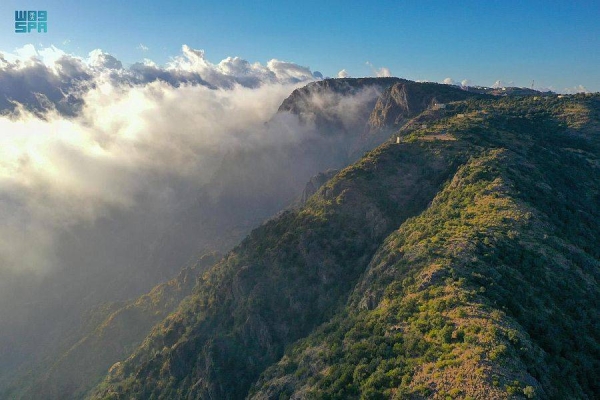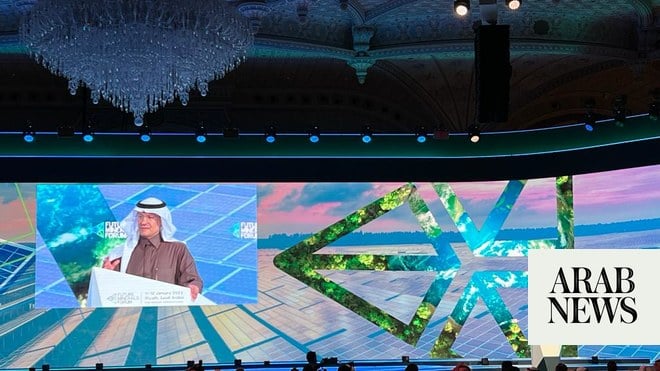
With an ever-increasing shift toward renewable energy, it seems that copper extraction is set for an upswing
CAIRO: Kazakhstan’s attendance at next week’s Future Mineral Forum in Saudi Arabia is looking increasingly unlikely following the protests sweeping the nation — just as the country is on the cusp of exploiting a growing demand for the copper reserves it has below its surface.
The demonstrations — sparked by a dramatic rise in car fuel prices — led Kazakhstan’s president Kassym-Jomart Tokayev to dismiss the entire government before issuing a state of emergency.
As such, there is likely to be an empty chair at the Forum set to begin on Jan. 11 in Riyadh.
If there is a Kazakhstan absence from the three-day event, it will be a missed opportunity for the country to explore business opportunities in its minerals reservoir, namely in copper mining.
Compared to conventional energy sources, renewable energy generation is much more copper intensive, providing multiple opportunities to KAZ Minerals — one of the largest copper producers in Kazakhstan.
With an ever-increasing shift toward renewable energy, it seems that copper extraction is set for an upswing, and KAZ Minerals is welcoming this development.
In 2020, Kazakhstan was the world’s second largest producer of chromium with a global share of 16.8 percent and an output of 6.7 million tons. (Supplied)
The Central Asian republic, a country with a wealthy stock of minerals, boosted its copper production by a yearly 3.2 percent to 580,000 tons in 2020, or around 3 percent of global output, according to estimates by the US Geological Survey.
KAZ Minerals was solely respon- sible for the production of 306,000 tons during the year, with production mainly deriving from the Aktogay and Bozshakol mines, together making up 253,200 tons of the company’s total supply.
Copper is a very efficient conduit, making it well-placed for renewable energy generation from solar, hydro, thermal and wind energy sources, according to the International Copper Association and the Copper Alliance.
The metal also aids in reducing CO2 emissions and the power needed to supply electricity. In addition, it is a highly recyclable material, cementing its place as one of the leading renewable resources, the organization added.
“Increasing penetration of renewables in the energy mix and carbon neutrality targets announced by various countries augur well for copper-intensive green end-use sectors,” Wood Mackenzie — a global energy research and consultancy — was cited by KAZ Minerals in its website.
However, it’s not only copper that is in abundance in the former Soviet republic; the country is a large supplier of many other minerals. This is shown through the sizable share of the mining and quarrying sector in Kazakhstan’s gross domestic product, making up 12.2 percent of output in 2020, official data revealed.
HIGHLIGHTS
The Central Asian republic, a country with a wealthy stock of minerals, boosted its copper production by a yearly 3.2 percent to 580,000 tons in 2020, or around 3 percent of global output, according to estimates by the US Geological Survey.
In 2020, Kazakhstan was the world’s second largest producer of chromium with a global share of 16.8 percent and an output of 6.7 million tons. The country also had the biggest known reserves of the mineral, standing at 230 million tons.
In 2020, Kazakhstan was the world’s second largest producer of chromium with a global share of 16.8 percent and an output of 6.7 million tons, estimated data from the US Geological Survey showed. The country also had the biggest known reserves of the mineral, standing at 230 million tons.
The world’s largest landlocked country was also a major extractor of gold, as it produced 100 tons of the commodity in 2020. This is compared to China, the world’s top supplier, which had an output of 380 tons, the Virginia-based organization said.
Moreover, Kazakhstan has 12 percent of the world’s uranium resources and produced 43 percent of the metal’s global output in 2020, according to the World Nuclear Association.
It is also one of the top producers of lead, manganese, zinc and iron ore, among others.
Kazakhstan is seeking to attract private investment in the mining sector, despite government and state-owned firms’ ability to finance the sector’s projects, GRATA International, an international law firm, said.
This is why the country entered several international and bilateral investment treaties. It also established the Astana International Financial Center — where disputes may be resolved under common law principles.
With the exception of uranium, Kazakhstan doesn’t impose restrictions on foreign investments in the exploration and mining sector related to solid minerals, except for artisanal mining licenses issued to Kazakh citizens only.
Topics: FMS2022
RELATED
UPDATE 1541Kazakhstan update: Key oil field hit by protests; uranium output unaffected
Kazakhstan update: Key oil field hit by protests; uranium output unaffected
908612 policemen, ‘dozens’ of protestors killed in Kazakhstan unrest
12 policemen, ‘dozens’ of protestors killed in Kazakhstan unrest
NEOM begins to take shape in 2021
NEOM begins to take shape in 2021
Updated 07 January 2022
ARAB NEWS
January 07, 2022
00:27
506
The futuristic city is expected to welcome its first residents by 2024, says CEO
RIYADH: NEOM, the $500 billion (SR1.9 trillion) jewel in the crown of the Kingdom’s Vision 2030 plans, took several strides forward this year with the announcement of two major projects and news that the region could welcome its first visitors in 2024.
The new net-zero megacity on the Kingdom’s northwest Red Sea coast will cover 10,000 square miles, an area 33 times the size of New York, and will be powered entirely by clean energy.
The futuristic car-free region will be run by advanced technologies such as human-machine fusion, artificial and predictive intelligence, and robotics. More than 1 million people will live in the area that will also host sporting, cultural, scientific and tourist attractions.
The region is the flagship giga-project of Saudi Arabia’s Vision 2030 plans, to diversify its economy from oil, ease social customs and boost investment.
Nadhmi Al-Nasr, CEO of NEOM. (Supplied)
Crown Prince Muhammad bin Salman launched the project, which is backed by the Kingdom’s sovereign wealth body the Public Investment Fund, in 2017.
The NEOM company says the megacity will also seek outside investors for the project, which is projected to contribute $48 billion to the Kingdom’s gross domestic product by 2030.
Major earthworks and tunneling through mountains has already begun in the region that houses 1,500 people, NEOM CEO Nadhmi Al-Nasr told Bloomberg TV in October.
He said: “It’s a huge undertaking. Today if you go to NEOM you will see construction all over, you will see earthworks going on all over, you will see regions that are being developed.”
One of the two key projects that were announced this year is THE LINE, a 105-mile long green city, which will have its own schools, clinics, leisure facilities, and open spaces within a five-minute walk.
The project is expected to create 380,000 jobs and to contribute SR180 billion to the Kingdom’s GDP by 2030.
Al-Nasr told Bloomberg TV that the city could welcome its first residents by 2024.
The other key announcement this year was the launch of the OXAGON, an eight-sided city that will be an industrial district and port. NOEM said the area will be “home to the world’s first fully automated port and integrated logistics hub.”
Half of OXAGON will float on the Red Sea, where around 10 percent of the world’s trade sails pass in container ships.
Today if you go to NEOM you will see construction all over, you will see earthworks going on all over, you will see regions that are being developed.
Nadhmi Al-Nasr, CEO of NEOM
NEOM says the industrial city will use the Internet of Things, artificial intelligence and robotics to create “a seamless integrated, intelligent and efficient supply chain.”
It has been a busy year for NEOM. These are its highlights:
April — NEOM awarded the US-based engineering firm Parsons Corporation a management consultancy role in OXAGON.
April — NEOM also said it would develop a plant to build up to 10,000 hydrogen fuel cell-powered commercial vehicles a year. It signed an agreement with US-based Hyzon Motors, which builds zero-emission hydrogen fuel cell-powered commercial vehicles, and Saudi conglomerate Modern Industrial Investment Holding Group as part of this move.
June — NEOM signed a deal with South Korean project and construction management firm HanmiGlobal to manage administrative services on THE LINE, which includes design, structure and execution.
FASTFACT
1 million
The futuristic car-free region will be run by advanced technologies such as human-machine fusion, artificial and predictive intelligence, and robotics. More than 1 million people will live in the area that will also host sporting, cultural, scientific and tourist attractions.
June — NEOM and King Abdullah University of Science and Technology also announced a joint project to establish the world’s largest coral garden at Shusha Island in the Red Sea area by the mega-city. The project, scheduled to be completed in 2025, covers 100 hectares on Shusha Island on the shores of the Red Sea, and bids to establish the region as a global center for protecting and restoring coral reefs.
July — NEOM company received tunnel work pre-qualifications for the China Railway Construction Corp. to operate.
September — NEOM invited bids for the construction of 31 km of tunnels. This project is a part of the infrastructure backbone of THE LINE and the deadline for bids is Dec. 30, according to GlobalData’s MEED.
October — NEOM announced technology firm Oracle as the first tenant of its hyper-scale data centre in the megacity. The data center will be based at the meeting point between terrestrial and sub-sea cable cables, allowing it to provide customers with fast and reliable connectivity.
November — the crown prince announced the launch of OXAGON, a floating, eight-sided city, set to be the largest floating industrial complex in the world.










